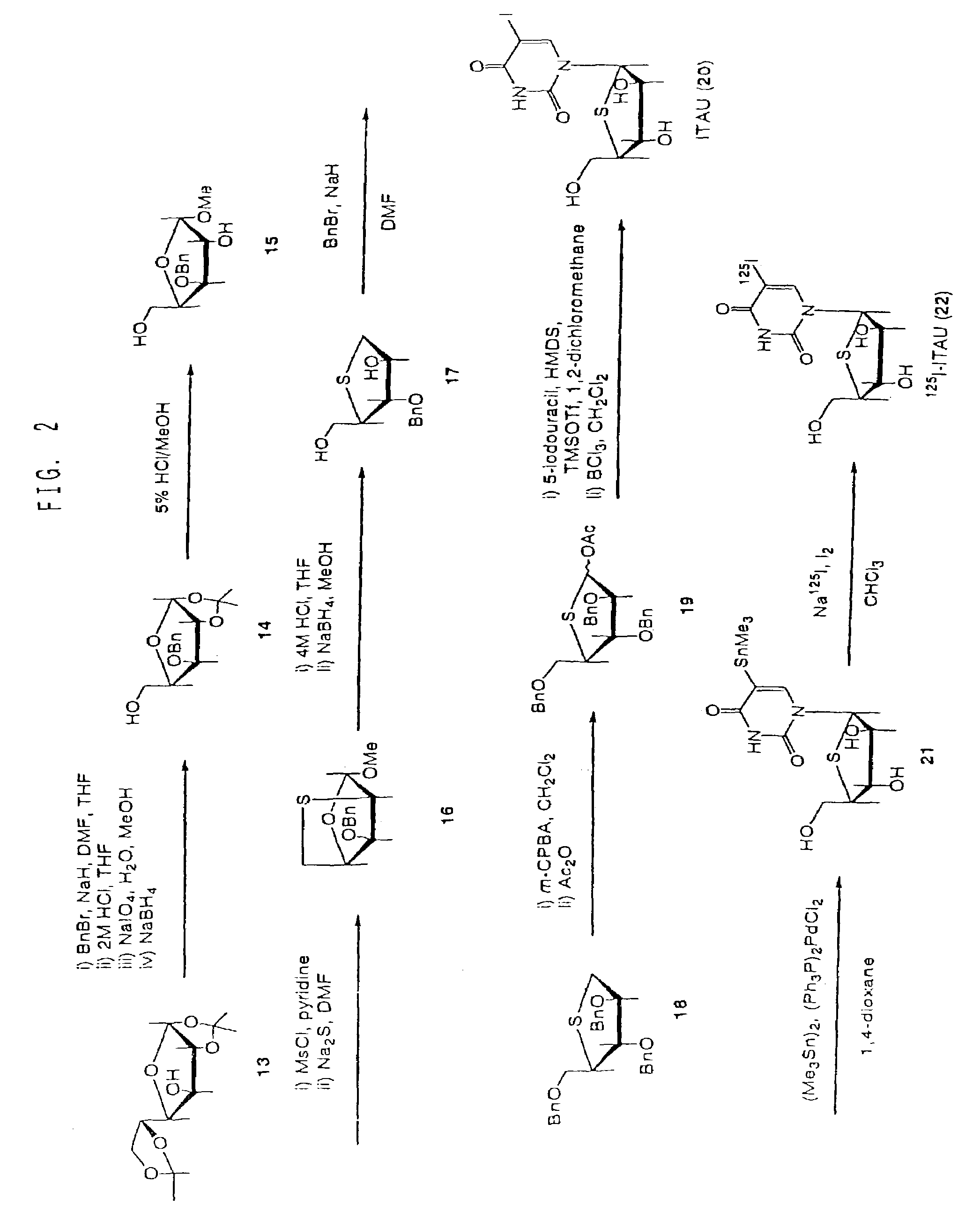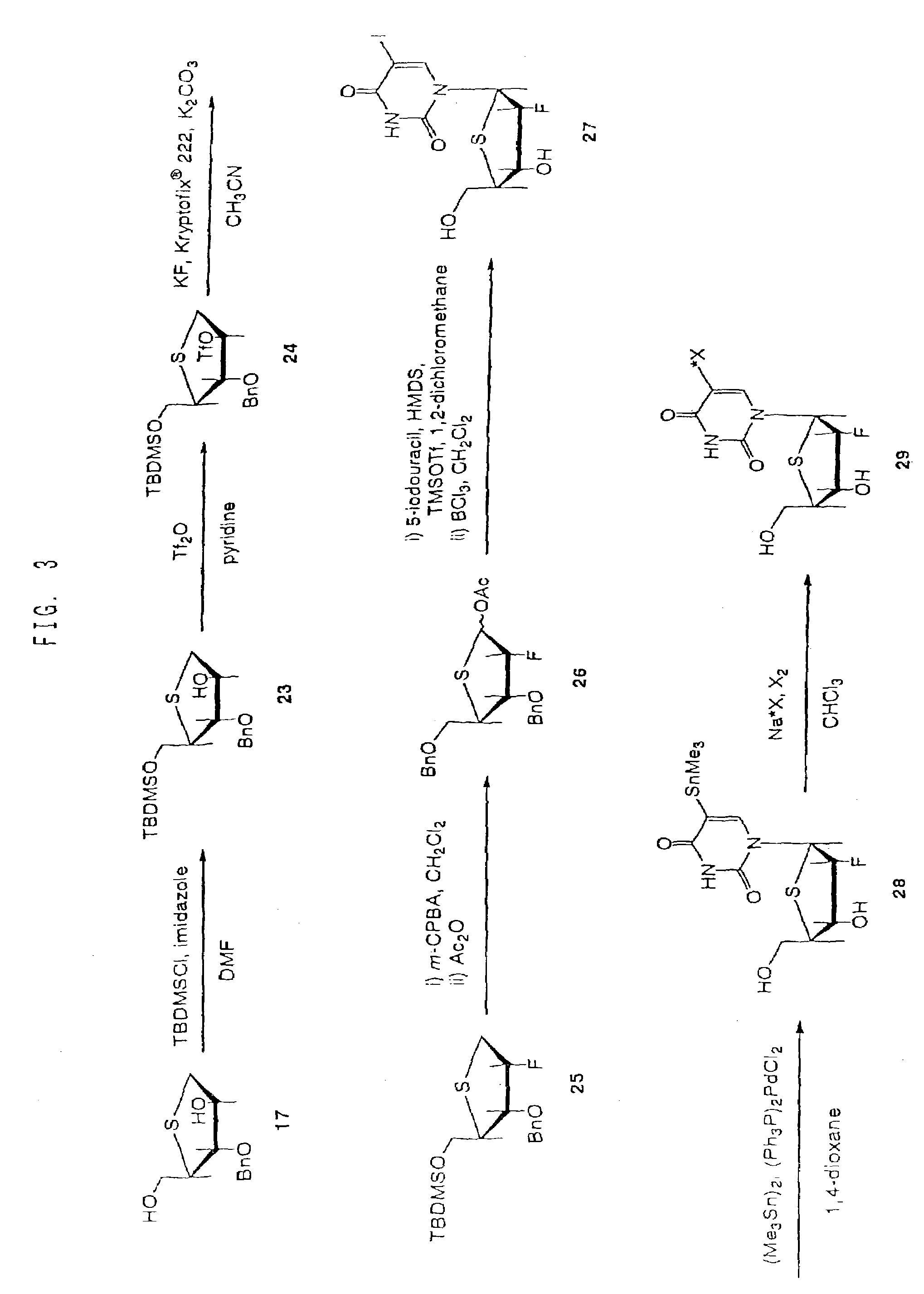Drugs for the diagnosis of tissue-reproductive activity or the treatment of proliferative diseases
a tissue-reproductive activity and drug technology, applied in the field of radiolabeled nucleoside derivatives, can solve the problems of difficult non-invasive evaluation of the proliferation activity of tumors, inability to become popular as a diagnostic technique of nuclear medicine imaging, and use of carbon-11-labeled thymidine in particular, so as to achieve local proliferative activity definition
- Summary
- Abstract
- Description
- Claims
- Application Information
AI Technical Summary
Benefits of technology
Problems solved by technology
Method used
Image
Examples
example 1
Synthesis of 5-trimethylstannyl-4′-thio-2′-deoxyuridine (Compound 11)
[0063]As shown in FIG. 1, benzyl-3,5-di-O-benzyl-2-deoxy-1,4-dithio-α,β-D-erythro-pentofuranoside (Compound 8) was synthesized, using 2-deoxy-D-erythro-pentose (Compound 1) as starting material, according to the method of Dyson M R et al. (Carbo. Res. 216, p. 237 (1991)). Further, 5-iodo-4′-thio-2′-deoxyuridine (ITDU: Compound 10) was produced from Compound 8 according to the method of Oivanen M et al. (J. Chem. Soc., Perkin Trans. 2, p. 2343 (1998)). Compound 10 was then used as a starting material to produce 5-trimethylstannyl-4′-thio-2′-deoxyuridine (Compound 11) according to the following procedure.
[0064]Compound 10 (9.5 mg, 0.026 mmol), bis(trimethyltin) (17.3 mg, 0.052 mmol) and bis(triphenylphosphine)palladium(II) chloride (5 mg) were dissolved in anhydrous 1,4-dioxane (3 mL) under argon atmosphere, and after heating at reflux for 3 hours, concentrated under reduced pressure. The residue was purified by sili...
example 2
Synsthesis of [I-125]-5-iodo-4′-thio-2′-deoxyuridine ([I-125] ITDU: Compound 12)
[0066]To 0.1N sodium hydroxide solution (50 μL) of [I-125]-sodium iodide (33 MBq), water (1 mL) and chloroform (1 mL) were added, and then chloroform solution (4.7 μL) of iodine (60 μg, 0.47 μmol) was added, and shaken for 10 seconds. After removing only the aqueous layer, ethyl acetate solution (100 μL) of Compound 11 (100 μg, 0.25 μmol) was added, and the resulting solution was left to stand at room temperature for 2 hours. One drop of 1N sodium thiosulfate solution was added, and chloroform was evaporated. After adding water (1 mL), the solution was passed through a Sep-Pak Plus QMA cartridge column. The column was washed with water (0.5 mL×2), and the resulting aqueous solution was combined to produce I-125-labeled Compound 12 (7.3 MBq, 22%).
example 3
Synthesis of [I-123]-5-iodo-4′-thio-2′-deoxyuridine ([I-123] ITDU: Compound 12)
[0067]To 0.1% ammonium iodide solution (1 mL) containing [I-123]-ammonium iodide (2.0 GBq), 1N hydrochloric acid (0.1 mL) and chloroform (1 mL) were added, and then chloroform solution (4.7 μL) of iodine (60 μg, 0.47 μmol) was added, and shaken for 10 seconds. After removing only the aqueous layer, ethyl acetate solution (100 μL) of Compound 11 (100 μg, 0.25 μmol) was added and left to stand at room temperature for 2 hours. One drop of 1N sodium thiosulfate solution was added, and chloroform was evaporated. After adding water (1 mL), the solution was passed through a Sep-Pak Plus QMA cartridge column. The column was washed with water (0.5 mL×2), and the resulting aqueous solution was combined to produce I-125-labeled Compound 12 (228 MBq, 15%).
PUM
| Property | Measurement | Unit |
|---|---|---|
| diameter | aaaaa | aaaaa |
| diameter | aaaaa | aaaaa |
| radioactive | aaaaa | aaaaa |
Abstract
Description
Claims
Application Information
 Login to View More
Login to View More - R&D
- Intellectual Property
- Life Sciences
- Materials
- Tech Scout
- Unparalleled Data Quality
- Higher Quality Content
- 60% Fewer Hallucinations
Browse by: Latest US Patents, China's latest patents, Technical Efficacy Thesaurus, Application Domain, Technology Topic, Popular Technical Reports.
© 2025 PatSnap. All rights reserved.Legal|Privacy policy|Modern Slavery Act Transparency Statement|Sitemap|About US| Contact US: help@patsnap.com



